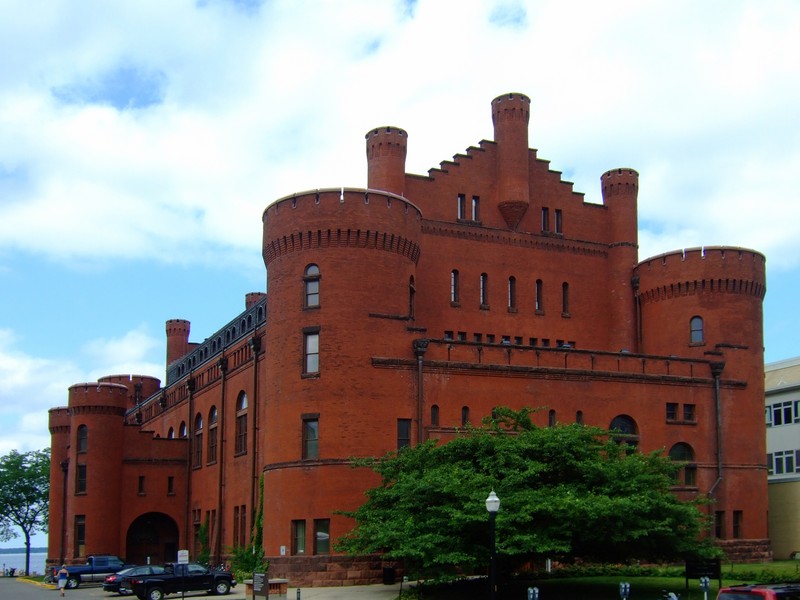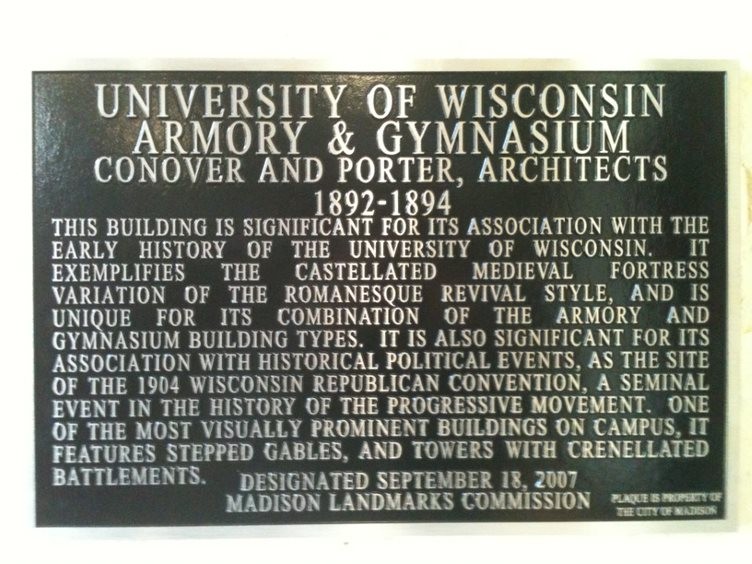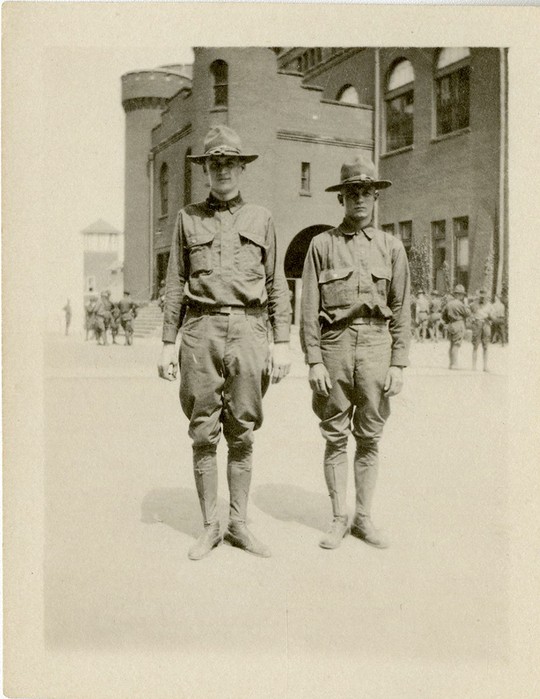Red Gym
Introduction
Text-to-speech Audio
Images
The Red Gym

Red Gym Historical Plaque

Photograph of two World War I soldiers posed in front of the Red Gym in Madison, Wisconsin.

Backstory and Context
Text-to-speech Audio
Before the Red Gym, soldiers practiced drills in what was then open space in front of the present day building. The new armory in 1894 provided space for drills with a second floor room that was 160 feet by 93 feet, with a clear height of 43 feet. Along with the drill hall, the armory included a commandant’s office with a fireproof ammunition safe, a gun room, staircases wide enough for a battalion in column of fours, and even 2 rifle ranges on the third floor, each 160 feet long.
The athletic facilities were also state-of-the-art for the time. Under the floor on the first level was a swimming tank, 80 by 20 feet, with a depth of four to six feet. The third floor gymnasium space approached the size of the drill hall at 160 feet by 65 feet, the largest gymnasium in the United States when it was built. At 26 feet, the third floor ceiling was high enough for a baseball cage. Efficiently utilizing the space, there was a dropped running track along the entire perimeter of the third floor. Run it twelve times to equal a mile.
The University of Wisconsin Armory and Gymnasium saw the training of countless soldiers. It came alive with the excitement of Badger basketball games from 1911 until 1930, at which time games moved to the Field House and later to the Kohl Center. The size of the space also made it a favorite spot for larger social and political gatherings. The Red Gym is a National Historic Landmark for its role in state and national Progressive-Era politics. It’s where Wisconsin Governor and U.S. Senator, Robert M. LaFollette, helped the Progressive Party to gain control of the Wisconsin Republican Party in 1904. The so-called “Gymnasium Convention” led to progressive reforms in Wisconsin and throughout the United States. For six decades beginning in 1928, it was the final stop in the registration process for students attending the University of Wisconsin.
What was once a modern marvel, became woefully inadequate over time. The university built newer, bigger gymnasiums and natatoriums. The Red Gym was scheduled for demolition by the 1950’s. Delays in building new facilities, meant delays in demolition. By the 1960’s it was still being used for athletic activities and as headquarters for the ROTC. During Viet Nam era protests, an arsonist set fire to what he thought was the ROTC offices. There was extensive damage, not to the ROTC offices, but to the Water Resources Management Program offices. Ironically, the fire might have saved the building, generating interest in the structure and its history, leading to repairs and adaptive repurposing. Today the Red Gym is home to offices for student services, and community spaces.
Sources
Wisconsin NHL University of Wisconsin Armory & Gymnasium. National Archives Catalog. Accessed May 31, 2020. https://catalog.archives.gov/id/106779856
History of the Red Gym, 1894-1929. University of Wisconsin International Student Services. Accessed May 31, 2020. https://iss.wisc.edu/about/history-of-the-red-gym/1894-1929/
History of the Red Gym, 1930-1988. University of Wisconsin International Student Services. Accessed May 31, 2020. https://iss.wisc.edu/about/history-of-the-red-gym/1930-1988/
History of the Red Gym, 1989-present. University of Wisconsin International Student Services. Accessed May 31, 2020. https://iss.wisc.edu/about/history-of-the-red-gym/1989-present/
James Steakley, CC BY-SA 3.0 <https://creativecommons.org/licenses/by-sa/3.0>, via Wikimedia Commons
James Steakley, CC BY-SA 3.0 <https://creativecommons.org/licenses/by-sa/3.0>, via Wikimedia Commons
Olson, Michael G. Red Gym Plaque. May 26, 2020, Madison.
John Rafferty photographs, [between 1914-1918], WVM Mss 1961. Wisconsin Veterans Museum (Madison, Wis).
